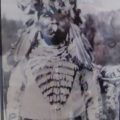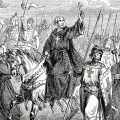
By 350 years ago, in 1668, the impact of the invading European traders, colonists, and missionaries was resulting in many changes for Indian people. The European market demands for North American furs and Indian interest in obtaining European manufactured goods changed the relationships between Indians and animals and between the Indian nations.
Trade with the Europeans changed Native American material culture. This included an increasing dependence on trade to obtain metal for arrow heads which replaced stone; cloth for decoration and clothing; metal pots and pans; firearms; glass beads. Indian people quickly found that metal axes, hatchets, fish hooks, and knives were superior to those made of stone.
Trade
Médard Chouart, Sieur Des Groseilliers, an enterprising coureurs de bois, with the financial support of a consortium of English businessmen, reached Hudson Bay in a 40-ton ship, wintered at the Rupert River, and then returned with a cargo of furs. In their book The Atlas of North American Exploration From the Norse Voyages to the Race to the Pole, William Goetzman and Glyndwr Williams write:
“This was a decisive moment in the history of the Canadian fur trade.”
Groseilliers felt that this was the best way to trade with the Cree for beaver fur. At this time, the Cree were considered the best hunters in North America. Groseillers formally purchased land from the Cree for a trading post and established a “League of Friendship.”
In Wisconsin, some Mascouten, Miami, Kickapoo, and Illinois resettled in the Green Bay area to avoid an Iroquois raiding party and to establish better relationships with the tribes who were trading with the French. When these pedestrian tribes—they hunted on foot rather than with canoes—sent an invitation to the French, it was intercepted by the Potawatomi. The Potawatomi attempted to dissuade the French from meeting with the visiting tribes, telling the French that these tribes had no beaver. Anthropologist James Clifton, in his entry on the Potawatomi in the Handbook of North American Indians, reports:
“The Potawatomi had recently returned from their first visit to Montreal and were jealous of their prestige, new wealth, and trade relationships, hoping to maintain a position of ascendancy with other tribes in the area.”
The French, however, met with the other tribes and the Potawatomi continued to cooperate with the French traders.
Migrations
One of the consequences of the fur trade was a dislocation of a number of Indian tribes. As conflicts over trade and hunting territory increased in the east, the warfare with powerful nations such as the Iroquois Confederacy pushed many tribes west. Many Algonquian-speaking groups, such as the Kickapoo, Mascouten, Ottawa, Sauk, Fox, Potawatomi, and Miami, and Iroquois-speaking tribes such as the Huron, Petun (Tobacco), and Neutral, pushed into western areas such as the present-day state of Wisconsin. This, in turn, placed new strains on the environment and created tensions with the tribes who were already living in the west.
The Shawnee, without firearms to defend themselves from the Iroquois war parties, abandoned most of the upper Ohio Valley. They broke into four groups. Two of the groups moved south toward the Cherokee and the Cherokee allowed one group of Shawnee to settle in the Cumberland Basin where they served as a buffer against the Cherokee’s enemy the Chickasaw. The second Shawnee group was given permission by the Cherokee to settle on the Savannah River in South Carolina where they could provide the Cherokee with protection against the Catawba.
A third group of Shawnees sought refuge with their “grandfather” people: the Delaware. They settled in the Susquehanna River in southern Pennsylvania.
The fourth group of Shawnees moved west into Illinois where they allied themselves with the Miami and Illinois so that they could continue their war against the Iroquois.
English
In Connecticut, Richard Haughton bought a neck of land called Massapeag from the Mohegan sachem Uncas. According to the agreement, Haughton was to plant the land in the summer and to graze cattle there in the winter. No pigs were to be kept on the land.
In Maryland, the Nanticoke and Assateague signed a peace treaty with the English colonists.
Christianity
One of the goals of some of the European invaders was to convert the Indians to Christianity. Christian missions were established among many of the Indian nations.
In New York, the Jesuits established permanent missions at each of the three main Cayuga towns. The largest of these missions, Saint Joseph, was built at the town of Oiogouen.
In Wisconsin, the Jesuits established a mission in conjunction with a trading post at La Baye. The post was to serve the Winnebago, Menominee, Sac, Fox, Miami, and Kickapoo.
In Wisconsin, the Kichakonk band of Ottawa converted to Christianity to gain greater influence with the French. Historian Robert Bieder, in his book Native American Communities in Wisconsin 1600-1960: A Study of Tradition and Change, reports:
“In accepting Christianity the Kishakonk anticipated stronger links with the French and a more favored position regarding French trade and protection.”
The Cayuga asked the French for missionaries and in response two Sulpicians—Claude Trouvé and François de Selignac—were sent to open a mission at their village on the Northern shore of Lake Ontario.




Leave a Reply